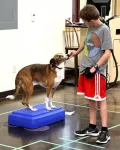(Press-News.org) MADISON — Researchers can use the light naturally thrown off by biological specimens to better study the different states of stem cells in the nervous system, thanks to a tool developed at the University of Wisconsin–Madison, brightening their chances for studying the way stem cells age.
The UW–Madison team combined autofluorescence — that natural light emission — and sequencing genetic material in single cells to study the behavior of neural stem cells. Autofluorescence is often considered a hindrance, as it can obscure the glowing labels researchers use to track specific signals within a cell. In their new technique, however, the researchers found the signatures of autofluorescence can be used to study stem cells’ dormant state, known as quiescence.
They published their findings recently in the journal Cell Stem Cell.
“The quiescent state is very important, because the exit from quiescence is the rate-limiting step in making newborn neurons in the adult brain. Aging and neurological diseases limit this exit from quiescence, so we have a great need to study adult neural stem cells in their different cell states,” says Darcie Moore, the senior author on the study, a professor of neuroscience and member of UW–Madison’s Stem Cell and Regenerative Medicine Center. “Our goal was to create a new tool that could identify if an adult neural stem cell was quiescent and its different substates (dormant or resting quiescence), or if the cell is activated, entering into the cell cycle.”
Moore partnered with Melissa Skala, a UW–Madison biomedical engineering professor, Morgridge Institute for Research investigator and member of the Stem Cell and Regenerative Medicine Center whose lab has been developing fluorescence lifetime imaging to study the autofluorescent signatures associated with single cells.
When cells shift from active to quiescent states, the presence and abundance of certain proteins important to metabolism change. These molecules alter the way light is absorbed and emitted back out of the cell. By focusing on light emitted by parts of the cell that change in key ways with quiescence, the researchers identified the light “signature” that matches a target cell state.
“These natural signals within the cell can reliably identify cell function and identity,” Skala says. “It's like nature is trying to tell us all the secrets of life.”
By sequencing RNA — a kind of working copy of DNA used to produce the proteins that make things happen in cells — in the mouse neural stem cells they studied, the researchers confirmed matches between cell state and light signatures.
By identifying and decoding these autofluorescence signatures, Moore and Skala have developed a tool that can aid in studying adult neurological diseases and aging, but potentially also expand beyond neuroscience. They’ve already begun working with Colin Crist, a professor of human genetics at McGill University, to investigate the unique autofluorescent signatures present in muscle stem cells.
“Now that we've discovered that this research created not only a tool but gave us unique insight to cellular processes that are different between quiescent and activated neural stem cells, I feel even more strongly that identifying a cell based on how they act versus how they express one protein will shift studies from studying static systems to dynamic systems,” says Moore. “That we can study these cells as they change throughout time without destroying them — while also seeing how these functional measures change — is very exciting.”
This research was supported in part by grants from the National Institutes of Health (P30 CA014520, 1S10RR025483-01, T32GM008688 and 1DP2OD025783) as well as the Vallee Foundation, Morgridge Institute for Research and Retina Research Foundation.
###
END
New tool provides researchers with improved understanding of stem cell aging in the brain
2024-03-27
ELSE PRESS RELEASES FROM THIS DATE:
Around half of people living with HIV in developed countries are now aged 50 years and over and at higher risk of becoming frail and having multiple comorbidities
2024-03-27
*Please mention the European Congress of Clinical Microbiology and Infectious Diseases (ECCMID 2024, Barcelona, 27-30 April) if using this material*
A new research review to be presented at a pre-congress day for this year’s European Congress of Clinical Microbiology & Infectious Diseases (ECCMID 2024) will focus on the growing prevalence of HIV in older adults, with, using England as an example, half of adults accessing care aged now 50 years and older, and around 1 in 11 aged 65 years and older. Similar trends exist in Italy and other ...
You are never too old for an STI – more older adults being diagnosed with STIs such as gonorrhea and syphilis
2024-03-27
Infectious disease expert addresses how to manage the rise in sexually transmitted infections in older adults.
STIs in Americans aged 55 to 64 years have more than doubled over the past decade; in England the number of over 45s diagnosed with gonorrhoea and syphilis doubled between 2015 and 2019.
Availability of sildenafil (Viagra) in late 1990s had an impact on STIs in older men.
Sexual health campaigns overlook the needs and experiences of the baby boom generation.
Health professionals must be proactive in discussing sexual concerns and making sexual health a routine part of general health care for older adults.
**Note: ...
University of Minnesota researchers introduce enhanced brain signal analysis technique
2024-03-27
MINNEAPOLIS/ST. PAUL (3/27/2024) — University of Minnesota Medical School researchers have introduced a new, refined method for analyzing brain signals, enhancing our understanding of brain functionality. This research has the potential to improve treatments for neurological conditions such as Parkinson's disease, pain, epilepsy and depression. The findings were recently published in NeuroImage.
"This breakthrough provides a more detailed understanding of the brain's complex activity, akin to upgrading from a basic telescope to a sophisticated space observatory,” said David Darrow, MD, MPH, an assistant ...
Aston University research center to focus on using AI to improve lives
2024-03-27
• New centre specifically focuses on using AI to improve society
• Current research is designed to improve transport, health and industry
• “There have been a lot of reports focusing on the negative use of AI...this is why the centre is so important now.”
Aston University researchers have marked the opening of a new centre which focuses on harnessing artificial intelligence (AI) to improve people’s lives.
The Aston ...
Robot, can you say ‘cheese’?
2024-03-27
What would you do if you walked up to a robot with a human-like head and it smiled at you first? You’d likely smile back and perhaps feel the two of you were genuinely interacting. But how does a robot know how to do this? Or a better question, how does it know to get you to smile back?
While we’re getting accustomed to robots that are adept at verbal communication, thanks in part to advancements in large language models like ChatGPT, their nonverbal communication skills, especially facial expressions, have lagged far behind. Designing a robot that can not only make a wide range ...
Filters, coupled with Digital Health Program, reduced arsenic levels by nearly half in study participants in households relying on well water in American Indian Communities
2024-03-27
A community-led water-testing project made up of households that rely on private well water with high arsenic levels saw on average a 47 percent drop in participants’ urinary arsenic levels after filters were installed and a digital health program was implemented, according to a new study led by researchers at the Johns Hopkins Bloomberg School of Public Health. Over the two-year study period, participating households received phone calls to encourage use of the filter and a reminder to replace the filter cartridge.
For the study—a ...
Oregon State dog-training program helps increase physical activity among kids with disabilities
2024-03-27
CORVALLIS, Ore. — By engaging regularly with their family dog and teaching it a series of tricks and commands, children with developmental disabilities experienced a significant increase in their daily physical activity, a new study from Oregon State University researchers found.
Children in the experimental group increased their moderate to vigorous physical activity by 17 minutes per day, while simultaneously reducing their sedentary time by nearly an hour per day.
“We often talk about physical activity as just fitness or exercise, but ...
Unlocking visible femtosecond fiber oscillators: A breakthrough in laser science
2024-03-27
The emergence of ultrafast laser pulse generation, marking a significant milestone in laser science, has triggered incredible progress across a wide array of disciplines, encompassing industrial applications, energy technologies, life sciences, and beyond. Among the various laser platforms that have been developed, fiber femtosecond oscillators, esteemed for their compact design, outstanding performance, and cost-effectiveness, have become one of the mainstream technologies for femtosecond pulse generation. However, their operating wavelengths ...
Long-period oscillations control the Sun’s differential rotation
2024-03-27
The Sun’s differential rotation pattern has puzzled scientists for decades: while the poles rotate with a period of approximately 34 days, mid-latitudes rotate faster and the equatorial region requires only approximately 24 days for a full rotation. In addition, in past years advances in helioseismology, i.e. probing the solar interior with the help of solar acoustic waves, have established that this rotational profile is nearly constant throughout the entire convection zone. This layer of the Sun stretches ...
A combination of approved drugs enhances the delivery of anti-bacterial medications to treat tuberculosis
2024-03-27
BOSTON – Tuberculosis (TB) is often overlooked in developed countries such as the United States, but this bacterial infection remains one of the deadliest diseases globally and results in millions of deaths annually.
Deaths can occur even with treatment, sometimes because of drug resistance in TB bacteria and other times due to poor delivery of TB-targeting drugs to patients’ infected lung tissue.
To address the latter challenge, a team led by researchers at Massachusetts General Hospital (MGH) in collaboration with scientists at the National Institute of Allergy and ...




